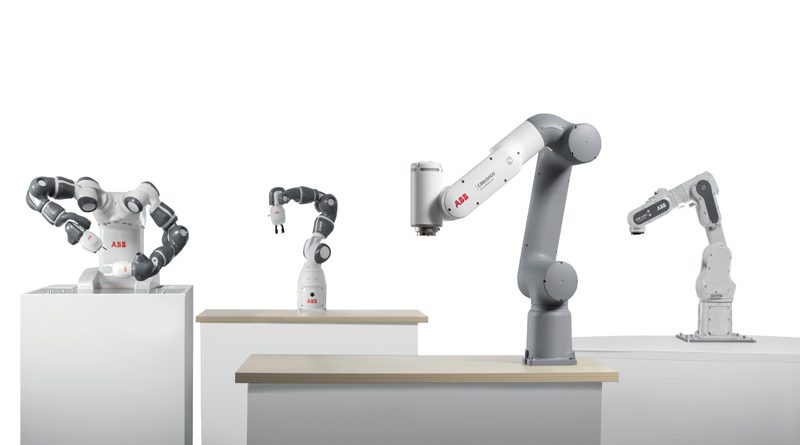A family of cobots at assembly’s service
YuMi, GoFa and SWIFTI: these are ABB’s three cobots, each with its own peculiarities, covering all the possibilities of assembly. But they are not enough, there must be an entire software apparatus capable of making them operate, and ABB has obviously brought its expertise in that too. Valerio D’Angelo, Business Development Specialist Robotics at ABB, explained everything during his speech at the Assembly Week.
Let us pretend there is someone who does not know ABB Robotics: could you describe the company and its values in brief?
ABB Robotics is a leading global supplier of industrial robots, software and complete robot solutions for industry and beyond. We can claim, to date, an installed base of more than 400,000 robots worldwide and a presence in 53 countries. This widespread presence has been developed through decades of experience and innovation in the field of robotics, allowing us to support our customers by sharing competences which are not only related to products, but also to transversal knowledge of all industrial sectors: from automotive to pharmaceuticals, from plastics processing to food & beverage. Our robot portfolio is among the broadest in the market and allows us to provide specialized solutions in a wide range of processes, starting from the “traditional” industrial ones such as coating, welding and machining, up to modern production automation applications with high variability and low volumes, where collaborative robotics and ease of use take the lead.
The mission of ABB Robotics, or ABB Way, represents the main reason for our presence in the business, and can be summarized in three macro-objectives: the generation of added value, the drive for technological innovation aimed at achieving superior performance and the transformation towards a more productive and, above all, more sustainable society.
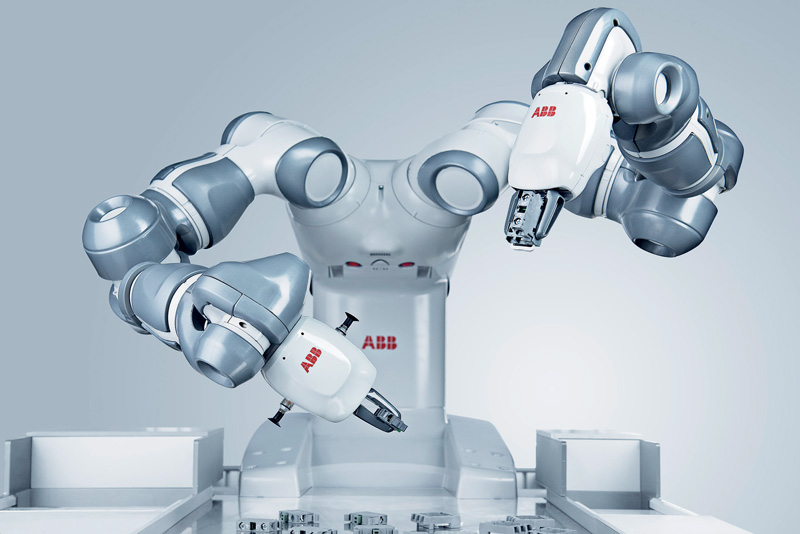
Let us talk about your YuMi-series one- and two-armed collaborative robot, a tool which has entered the daily routine of many assembly lines. Could you tell us about it? What is its added value? What support does it provide to human operators?
YuMi, the world’s first intrinsically collaborative robot and, to date, the only two-armed robot on the market, was first launched in 2015. Since 2019, the family has expanded with the single-arm version IRB 14050, which uses the latest generation Omnicore controller, to meet our customers’ needs for compactness and ease of use. Over the past six years, members of the YuMi Family have contributed to the improvement of many productions, working side by side with people, relieving them of repetitive and potentially dangerous tasks, increasing the repeatability, and therefore the quality, of many assembly processes. Limited to payloads of up to 0.5 kg, YuMi and Single Arm YuMi are designed to be collaborative even at their highest dynamic performance. Reaching linear speeds of up to 1.5 m/s, comparable to the handling speeds of human arms, they offer solutions which guarantee high productivity while ensuring safety. Thanks to the configuration with 7 controlled axes, YuMi reaches positions otherwise unreachable with the trajectories of a classic 6-axis anthropomorphic robot, avoiding potential dangerous collisions, while maintaining a positioning repeatability on the spot of the order of 0.02 mm, worthy of assembly processes in the electronics field. Besides the lightweight design and external padding, safety is achieved through a sophisticated control of the robot motion which, by measuring the current absorbed by the single motor, triggers an immediate stop of the arm in case of any impact with a person.
Safety is not the only fundamental feature of a collaborative robot, equally important is its simple programming. Thanks to the combination of the gravity compensation mode, the lead-through, which makes the robot yield to manual displacement while maintaining its stability, and the latest software interface developed by ABB for simplified block programming, the Wizard Easy Programming, no specialized skills are required and even the least experienced users will be able to readjust the robot’s work cycle, programming the assembly phases autonomously.
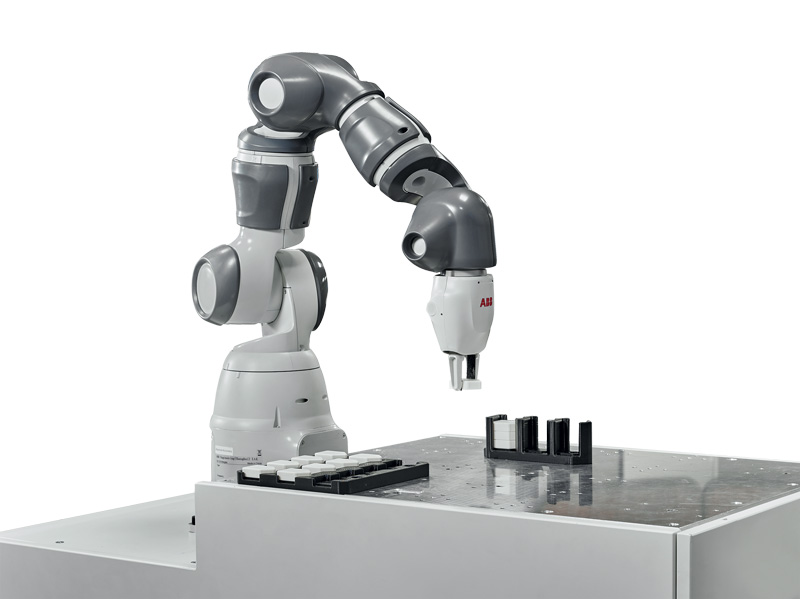
The YuMi series is no longer the only collaborative robot series manufactured by ABB; you recently launched GoFa and SWIFTI. What are the peculiarities of these two robots, and how can they optimize assembly processes?
Yes, the newcomers CRB 15000 and CRB 1100, respectively GoFa (Go Fast, Go Further!) and SWIFTI complete our collaborative range making it the most versatile on the market. The YuMi Family, in the matrix of collaborative robotic applications, covers the node of applications limited in force and power: even at maximum performance, provided that the cycle does not present hazards independent from the design of the robots, the total sharing of the working area of robot and operator is always possible. With GoFa and SWIFTI we cover the remaining nodes of the collaborative matrix. GoFa has features which are hardly inferior to a traditional industrial robot, with its 5 kg wrist capacity, 950 mm reach and a maximum speed of 2.2 m/s, it can be used in the assembly of even massive components, with high speed and precision or, for example, using appropriate “safe-designed” tools, in screwing and testing applications. But the fundamental characteristic of the GoFa is its equipment, in correspondence with each of the 6 axes, of force sensors, whose integration has allowed ABB to implement an accurate direct control of collisions. The GoFa is therefore a solution which, if integrated with appropriate safety systems capable of sensing the presence of a nearby operator, can be used in mixed solutions. When the person approaches, limiting the operating speed according to the forces involved, the robot can continue to move in control of force and power. When the person is out of the robot’s reach, the robot will work at full speed with performance verging on that of the classic industrial robot. Even in this case, ease of use is central: thanks to the direct control of individual axes the lead-through function is extremely effective, and thanks to the presence of two programmable buttons at the robot’s wrist (Arm Side Interface) simplified programming is increasingly within everyone’s reach.
However, in assembly processes where, in addition to precision, it is necessary to meet the demand for higher volumes, the robot must guarantee high dynamic performance. In these conditions, the process speeds of an operator are not compatible with those required by the automated cell and the sharing of the work area is limited to occasional activities, such as quality control, loading and unloading of the assembly machine or changing production recipes. In this borderline situation SWIFTI represents the most effective solution, since it combines the performance of a traditional industrial robot with the aspects of ease of use typical of collaborative robots. Like the Single Arm YuMi and GoFa, SWIFTI is equipped with a Wizard for simplified programming. It is also designed for the integration of secure sensing systems, such as laser scanners, and for intuitive manual handling through a device allowing the operator to move the robot without using the programming keypad toggle. In short, with the newcomers GoFa and SWIFTI, along with YuMi, ABB Robotics is able to cover all possible combinations of collaborative robotics, from total to intermittent workspace sharing.
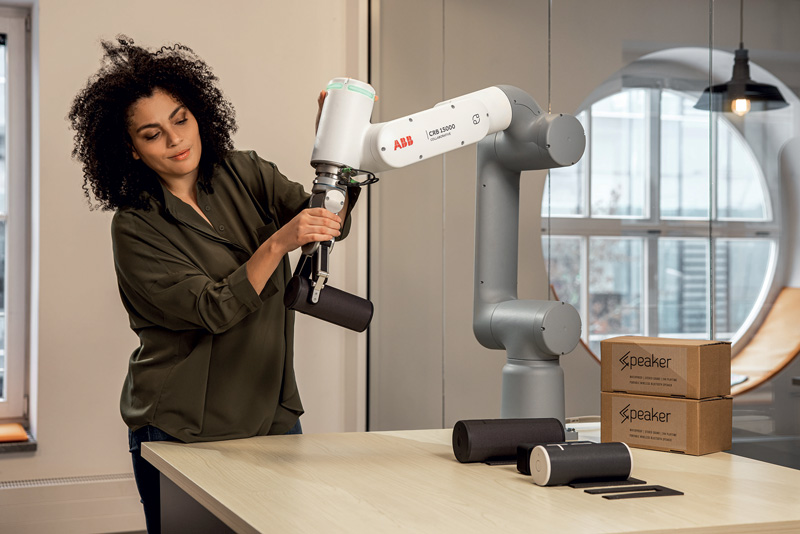
GoFa may be used to assemble components, even massive ones, with high speed and precision. 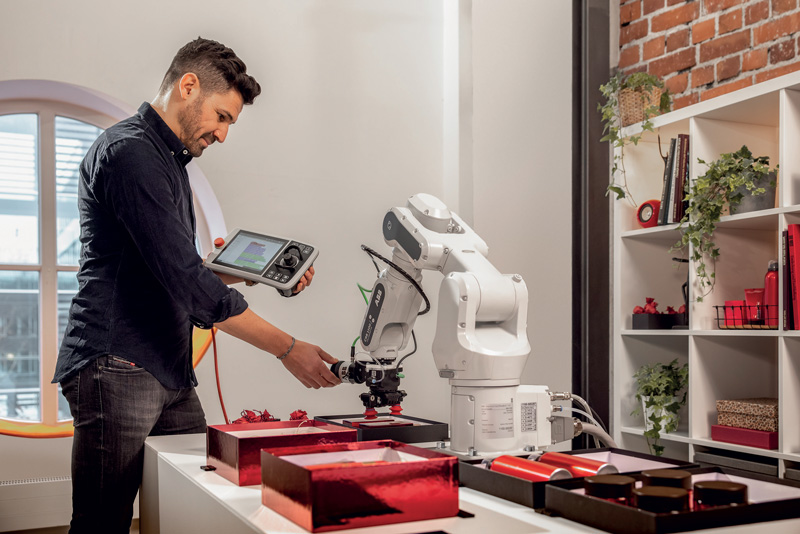
SWIFTI combines the performance of a traditional industrial robot with the user-friendly aspects typical of cobots.
Not just hardware: robots also need software. This is particularly important now that we are entering what has been called the “new normal,” where remote work has become commonplace. What tools does ABB offer in this regard? Were they designed in response to the pandemic or to a pre-existing need?
There can be no real technological innovation without a strong digital infrastructure. For several years, even before the pandemic, digitization and development of software solutions has been central to ABB’s strategy. The crisis generated by Covid-19 has substantially accelerated the development of software allowing the remote control of activities, as well as in everyday work, also in the design and programming of robotic cells. Our robots’ main asset is definitely RobotStudio, the software through which our partners meet all the needs arising during the design and implementation of a robot line: from feasibility studies to commissioning, from offline process programming to the optimization of an existing program. Our state-of-the-art simulation system allows our partners and end users to verify the reliability and feasibility of the process long before its realization, already in the offer phase, and with a high level of precision, thanks to the virtual controller, which replicates to the millisecond the real behavior of the robot, and to the smart components which allow the simulation of external peripherals, such as belts or generic movements of machines. With the virtualization enabled by RobotStudio, development costs on physical assets are reduced and start-up and testing times are accelerated. Returning to the theme of the centrality of the person in modern industry, it is important to take into careful consideration the design of production layouts.
The market is increasingly dynamic and, consequently, production areas must be ever more flexible and compact and allow humans to interact with machines safely and in an active way. RobotStudio supports the designer, thanks to the accurate simulation of the stopping times it is possible to verify, virtually and at every point of the trajectory, the final position which the robot would take up in case of an emergency stop. As a result, it is possible to accurately size the work areas, maximizing safety and optimizing dimensions. The other tools, now increasingly commonplace, are the Virtual and Augmented Reality functions. Also in this respect RobotStudio is at the forefront and, with VR, allows you to “touch with your hands” the virtual cell even before having placed a single piece, to verify in 3D the proportions in actual size and first-hand, and to program with dedicated tools robotic processes moving with a simple joystick in one hand a robot which in reality would weigh hundreds of pounds. With AR, on the other hand, all it takes is a smartphone to see the virtual assembly island projected, on a one-to-one scale, within the real factory layout, with consequent advantages in terms of end-user perception and verification of overall dimensions.
Other digital solutions from ABB Robotics, in addition to the aforementioned Easy Programming Wizard for our collaborative robots, include Connected Services, which allows the installed robot base to be remotely monitored and proactive maintenance to be adopted based on ABB data analysis algorithms, resulting in the prevention of destructive breakdowns and costly downtime. We also provide specialized process solutions, such as the PickMaster Twin for programming and managing the picking line and numerous PowerPacks for programming welding, painting, machining, 3D printing and more.

As we mentioned, we are in a “new normal” condition and many things are changing, including in the manufacturing world of course. What does ABB foresee for the future of the assembly world?
The assembly sector presents a multitude of relevant challenges in the field of modern automation, just to mention, for instance, the complexities which exist in the feeding of components to be assembled when the variability of products is high, and the need to integrate vision algorithms, now also 3D, for the reliable recognition of the correct type and position in space. The robot, and other surrounding machines, must cope with the demand for extreme flexibility required to adapt production while minimizing lead times for reconfiguring cells.
The world of assembly, precisely because it is difficult to automate, especially in the creation of high value-added assemblies, has been the domain of manual processes. Now that automation is necessary for fundamental reasons, such as ergonomics and productivity, it certainly represents a driving force in technological innovation, if compared to more rigid manufacturing environments with large product volumes and standardized processes. In this context, we need tools which make automation accessible to everyone through simple high-level programming interfaces, which free the technical figure responsible for the process from the need for specialized skills. ABB Robotics, with its next-generation Omnicore controllers, provides an application development environment based on WebServices communication technology. The RWS (Robot Web Services) infrastructure enables both the development of WebApps on board the robot programming keyboard, for intuitive operator interfaces, and the interoperability of communication with any PC-based applications which perform complex calculations through machine learning and AI algorithms, for instance. Both globally and locally, here in Italy, we are constantly in touch with industrial research realities and actively involved in technology transfer projects, from prototyping to production, and many of these are based on the issues of collaborative robotics in their broadest sense, from advanced human-robot interfaces for simplified programming to self-programming systems which dynamically readjust the robot cycle depending on the operator in front of them. In short, the future is rich and closer than it seems!

